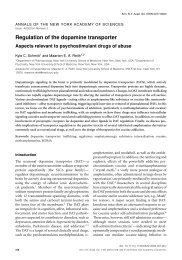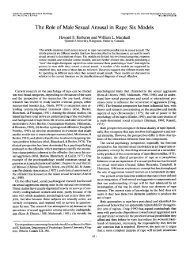How does stress increase risk of drug abuse - Addiction Research ...
How does stress increase risk of drug abuse - Addiction Research ...
How does stress increase risk of drug abuse - Addiction Research ...
You also want an ePaper? Increase the reach of your titles
YUMPU automatically turns print PDFs into web optimized ePapers that Google loves.
and how do these changes modify their ability to perceive,<br />
respond and cope with <strong>stress</strong>? Which if any <strong>of</strong><br />
such changes are associated with <strong>drug</strong>-seeking behavior?<br />
Does <strong>stress</strong> and/or abstinence symptoms impair production<br />
<strong>of</strong> adaptive coping in addicts? If so, what aspects <strong>of</strong><br />
coping are modified in addicts? Systematic research on<br />
these questions will lead to a greater understanding <strong>of</strong><br />
how <strong>stress</strong> is associated with relapse. Furthermore, such<br />
research may be significant in developing new treatment<br />
targets to reduce relapse both in the area <strong>of</strong> medication<br />
development as well as in developing behavioral treatments<br />
that specifically target the effects <strong>of</strong> <strong>stress</strong> on continued<br />
<strong>drug</strong> use and relapse in addicts.<br />
Conclusion<br />
This paper has examined how <strong>stress</strong> <strong>increase</strong>s the propensity<br />
to self-administer <strong>drug</strong>s. Possible mechanisms<br />
that have been put forth to explain how <strong>stress</strong> may <strong>increase</strong><br />
the vulnerability to chronic <strong>drug</strong> use were considered.<br />
In the larger context <strong>of</strong> genetic and vulnerability<br />
factors that have been found to <strong>increase</strong> the propensity to<br />
<strong>abuse</strong> substances, it is proposed that maladaptive <strong>stress</strong><br />
responses mediate the expression <strong>of</strong> such vulnerabilities<br />
with <strong>stress</strong> exposure. The second part <strong>of</strong> the paper highlighted<br />
that the transition to addiction is accompanied by<br />
neuroadaptations in brain <strong>stress</strong> and reward circuits.<br />
These alterations produce biological, cognitive and behavioral<br />
changes that may last for varying lengths <strong>of</strong><br />
time and contribute to perpetuation <strong>of</strong> addictive behaviors.<br />
Thus, the notion that such changes alter an addict’s<br />
ability to cope with <strong>stress</strong> thereby increasing the <strong>risk</strong> <strong>of</strong><br />
relapse is explored. While it is <strong>of</strong>ten assumed that addicts<br />
are predisposed to poor coping, the effects <strong>of</strong> <strong>drug</strong><br />
<strong>abuse</strong> on <strong>stress</strong> response and coping has not been systematically<br />
examined. The question <strong>of</strong> whether <strong>stress</strong> exposure<br />
results in decrements in adaptive coping thereby<br />
increasing the <strong>risk</strong> <strong>of</strong> relapse is raised. Some areas <strong>of</strong> future<br />
research are identified to promote a better understanding<br />
<strong>of</strong> the mechanisms underlying the association<br />
between <strong>stress</strong> and <strong>drug</strong> <strong>abuse</strong>.<br />
Acknowledgements Preparation <strong>of</strong> this review was supported<br />
by grants from the National Institutes <strong>of</strong> Health, P50-DA09241,<br />
R01-DA11077 and DA14038.<br />
References<br />
Acquas E, Carboni E, Di Chiara G (1991) Pr<strong>of</strong>ound depression <strong>of</strong><br />
mesolimbic dopamine release after morphine withdrawal. Eur<br />
J Pharmacol 193:133–134<br />
Adin<strong>of</strong>f B, Martin PR, Bone GH, Eckardt MJ, Roehrich L et al.<br />
(1990) Hypothalamic-pituitary-adrenal axis functioning and<br />
cerebrospinal fluid corticotrophin releasing hormone and corticotrophin<br />
levels in alcoholics after recent and long-term abstinence.<br />
Arch Gen Psychiatry 47:325–330<br />
Adin<strong>of</strong>f B, Risha-Flowers D, DeJong J, Ravitz B et al. (1991) Disturbances<br />
<strong>of</strong> hypothalamic-pituitary-adrenal axis functioning<br />
during withdrawal in six men. Am J Psychiatry 148:1023–<br />
1025<br />
353<br />
Adler MW, Bendotti C, Ghezzi D, Samanin R, Valzelli L (1975)<br />
Dependence to morphine in differentially housed rats. Psychopharmacology<br />
41:15–18<br />
Ahmed SH, Koob GF (1997) Cocaine- but not food-seeking behavior<br />
is reinstated by <strong>stress</strong> after extinction. Psychopharmacology<br />
132:289–295<br />
Allan CA Cooke DJ (1985) Stressful life events and alcohol<br />
misuse in women. A critical review. J Stud Alcohol 46:147–<br />
152<br />
Alexander BK, Coambs RB, Hadaway PF (1978) The effect <strong>of</strong><br />
housing and gender on morphine self-administration in rats.<br />
Psychopharmacology 58:175–179<br />
Alexander GE, DeLong MR, Strick PL (1986) Parallel organization<br />
<strong>of</strong> functionally segregated circuits linking basal ganglia<br />
and cortex. Rev Neurosci 9:357–381<br />
American Psychiatric Association (1994) Diagnostic and statistical<br />
manual-IV (DSM-IV). APA, Washington D.C.<br />
Anisman H, Waller TG (1974) Effects <strong>of</strong> inescapable shock and<br />
shock-produced conflict on self-selection <strong>of</strong> alcohol in rats.<br />
Pharmacol Biochem Behav 2:27–33<br />
Arborelius L, Owens MJ, Plotsky PM, Nemer<strong>of</strong>f CB (1999) The<br />
role <strong>of</strong> corticotrophin-releasing factor in depression and<br />
anxiety disorders. J Endocrinol 160:1–12<br />
Arnsten AFT, Goldman-Rakic PS (1998) Noise <strong>stress</strong> impairs prefrontal<br />
cortical cognitive function in monkeys. Arch Gen<br />
Psychiatry 55:362–368<br />
Aro S (1981) Stress, morbidity and health related behavior. A<br />
five-year follow-up study <strong>of</strong> metal industry employees. Scand<br />
J Soc Med 9:300–307<br />
Baumann MH, Gendron TM, Becketts KM, Heningfield JE,<br />
Gorelick DA, Rothman RB (1995) Effects <strong>of</strong> intravenous cocaine<br />
on plasma cortisol and prolactin in human cocaine <strong>abuse</strong>rs.<br />
Biol Psychiatry 38:751–755<br />
Belding M, Iguchi M, Lamb R (1996) Coping strategies and continued<br />
<strong>drug</strong> use among methadone maintenance patients.<br />
Addict Behav 21:389–401<br />
Blanchard DC, Blanchard RJ (1972) Innate and conditioned reactions<br />
to threat in rats with amygdaloid lesions. J Comp Physiol<br />
Psychol 81:281–290<br />
Bradley BP, Phillips G, Green L, Gossop M (1989) Circumstances<br />
surrounding the initial lapse to opiate use following detoxification.<br />
Br J Psychiatry 154:354–359<br />
Brewer DD, Catalano RF, Haggerty K, Gainey RR, Fleming CB<br />
(1998) A meta-analysis <strong>of</strong> predictors <strong>of</strong> continued <strong>drug</strong> use<br />
during and after treatment for opiate addiction. <strong>Addiction</strong><br />
93:73–92<br />
Brown EE, Fibiger HC (1993) Differential effects <strong>of</strong> excitotoxic<br />
lesions <strong>of</strong> the amygdala on cocaine-induced conditioned locomotion<br />
and conditioned place preference. Psychopharmacology<br />
113:123–130<br />
Brown EE, Robertson GS, Fibiger HC (1992) Evidence for conditioned<br />
neuronal activation following exposure to a cocainepaired<br />
environment: role <strong>of</strong> forebrain limbic structures.<br />
J Neurosci 12:4112–4121<br />
Brown SA, Vik PW, McQuaid JR, Paterson TL, Irwin MR, Grant I<br />
(1990) Severity <strong>of</strong> psychosocial <strong>stress</strong> and outcome <strong>of</strong> alcoholism<br />
treatment. J Abnorm Psychol 99:344–348<br />
Brownell KD, Marlatt GA, Lichtenstein E, Wilson GT (1986) Understanding<br />
and preventing relapse. Am Psychol 41:765–782<br />
Buczek Y, Le AD, Stewart J, Shaham Y (1999) Stress reinstates<br />
nicotine seeking but not sucrose solution seeking in rats.<br />
Psychopharmacology 144:183–188<br />
Carroll K, Power M, Bryant K, Rounsaville B (1993) One year<br />
follow-up status <strong>of</strong> treatment-seeking cocaine <strong>abuse</strong>rs: psychopathology<br />
and dependence severity as predictors <strong>of</strong> outcome.<br />
J Nerv Ment Dis 181:71–79<br />
Carroll K, Rounsaville B, Gordon L, Nich C, Jatlow P, Bisighini<br />
R, Gawin F (1994) Psychotherapy and pharmacotherapy for<br />
ambulatory cocaine <strong>abuse</strong>rs. Arch Gen Psychiatry 51:177–<br />
187<br />
Carter BL, Tiffany ST (1999) Meta-analysis <strong>of</strong> cue reactivity in<br />
addiction research. <strong>Addiction</strong> 94:327–340










